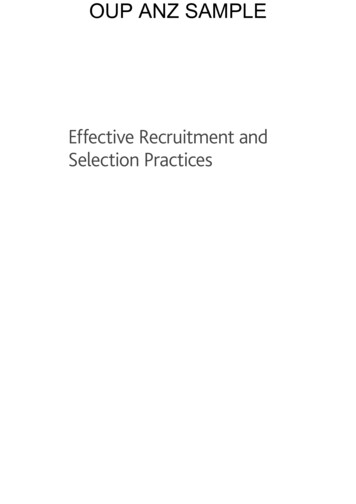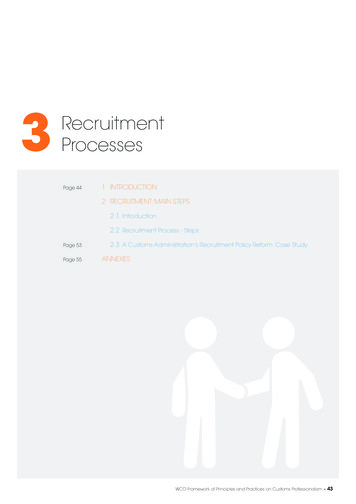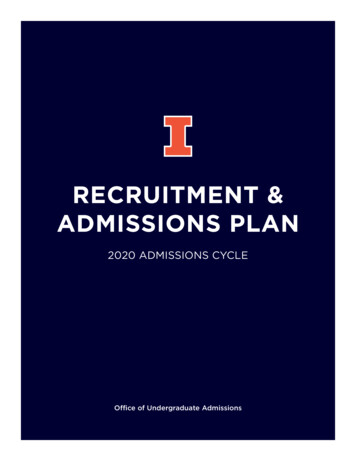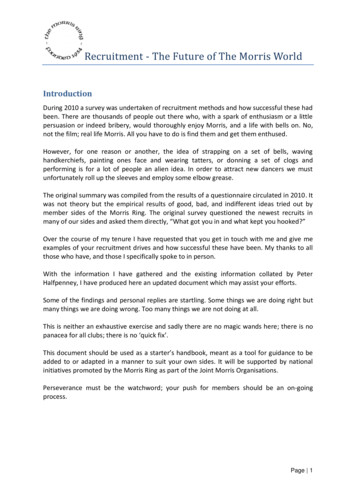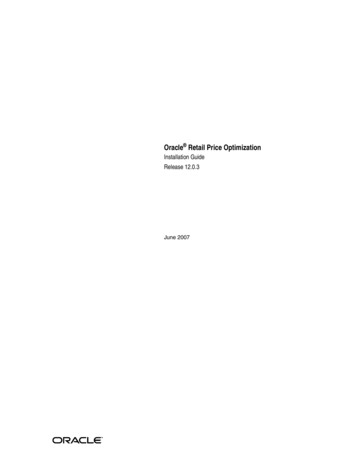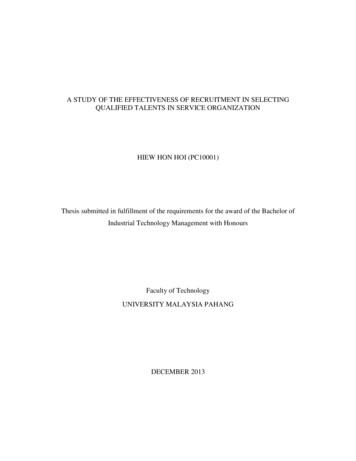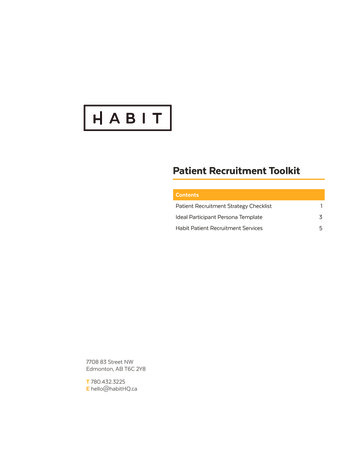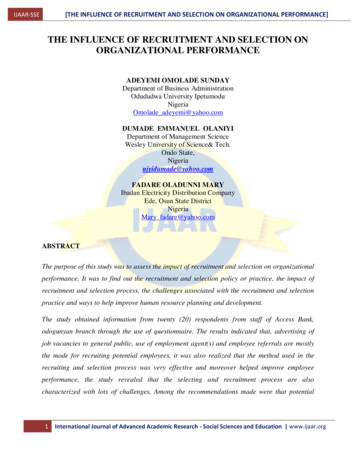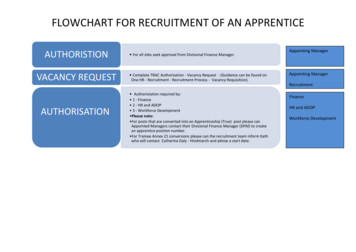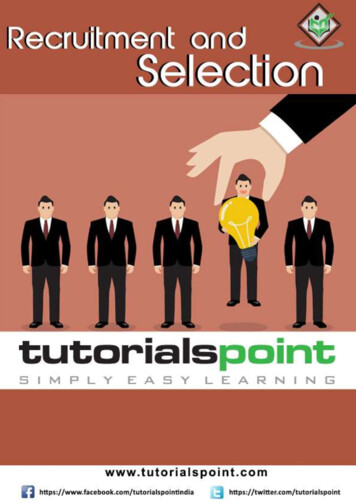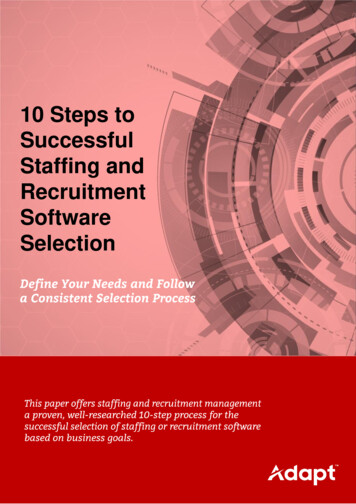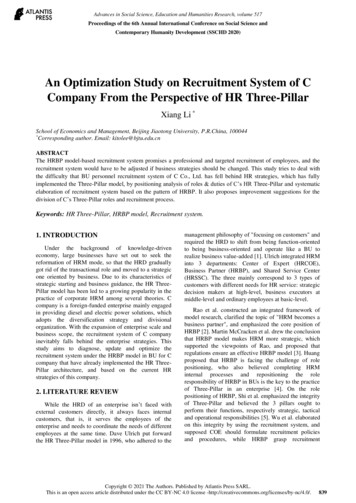
Transcription
Advances in Social Science, Education and Humanities Research, volume 517Proceedings of the 6th Annual International Conference on Social Science andContemporary Humanity Development (SSCHD 2020)An Optimization Study on Recruitment System of CCompany From the Perspective of HR Three-PillarXiang Li *School of Economics and Management, Beijing Jiaotong University, P.R.China, 100044*Corresponding author. Email: kitolee@bjtu.edu.cnABSTRACTThe HRBP model-based recruitment system promises a professional and targeted recruitment of employees, and therecruitment system would have to be adjusted if business strategies should be changed. This study tries to deal withthe difficulty that BU personnel recruitment system of C Co., Ltd. has fell behind HR strategies, which has fullyimplemented the Three-Pillar model, by positioning analysis of roles & duties of C’s HR Three-Pillar and systematicelaboration of recruitment system based on the pattern of HRBP. It also proposes improvement suggestions for thedivision of C’s Three-Pillar roles and recruitment process.Keywords: HR Three-Pillar, HRBP model, Recruitment system.1. INTRODUCTIONUnder the background of knowledge-driveneconomy, large businesses have set out to seek thereformation of HRM mode, so that the HRD graduallygot rid of the transactional role and moved to a strategicone oriented by business. Due to its characteristics ofstrategic starting and business guidance, the HR ThreePillar model has been led to a growing popularity in thepractice of corporate HRM among several theories. Ccompany is a foreign-funded enterprise mainly engagedin providing diesel and electric power solutions, whichadopts the diversification strategy and divisionalorganization. With the expansion of enterprise scale andbusiness scope, the recruitment system of C companyinevitably falls behind the enterprise strategies. Thisstudy aims to diagnose, update and optimize therecruitment system under the HRBP model in BU for Ccompany that have already implemented the HR ThreePillar architecture, and based on the current HRstrategies of this company.2. LITERATURE REVIEWWhile the HRD of an enterprise isn’t faced withexternal customers directly, it always faces internalcustomers, that is, it serves the employees of theenterprise and needs to coordinate the needs of differentemployees at the same time. Dave Ulrich put forwardthe HR Three-Pillar model in 1996, who adhered to themanagement philosophy of "focusing on customers" andrequired the HRD to shift from being function-orientedto being business-oriented and operate like a BU torealize business value-added [1]. Ulrich integrated HRMinto 3 departments: Center of Expert (HRCOE),Business Partner (HRBP), and Shared Service Center(HRSSC). The three mainly correspond to 3 types ofcustomers with different needs for HR service: strategicdecision makers at high-level, business executors atmiddle-level and ordinary employees at basic-level.Rao et al. constructed an integrated framework ofmodel research, clarified the topic of "HRM becomes abusiness partner", and emphasized the core position ofHRBP [2]. Martin McCracken et al. drew the conclusionthat HRBP model makes HRM more strategic, whichsupported the viewpoints of Rao, and proposed thatregulations ensure an effective HRBP model [3]. Huangproposed that HRBP is facing the challenge of rolepositioning, who also believed completing HRMinternal processes and repositioning the roleresponsibility of HRBP in BUs is the key to the practiceof Three-Pillar in an enterprise [4]. On the rolepositioning of HRBP, Shi et al. emphasized the integrityof Three-Pillar and believed the 3 pillars ought toperform their functions, respectively strategic, tacticaland operational responsibilities [5]. Wu et al. elaboratedon this integrity by using the recruitment system, andsupposed COE should formulate recruitment policiesand procedures, while HRBP grasp recruitmentCopyright 2021 The Authors. Published by Atlantis Press SARL.This is an open access article distributed under the CC BY-NC 4.0 license 9
Advances in Social Science, Education and Humanities Research, volume 517standards, and SSC convey employment info to theexternal environment [6]. Starting from the holisticcharacteristics of HR Three-Pillar model and usingdifferent research methods, studies above virtuallyrequire COE, HRBP and SSC to maintain consistentvalues and service business based on strategies in theapplication of recruitment system. Furthermore, Dangproposed the unity of enterprise internal values is ofsignificance to the implementation of HRBP model [7].In addition to the clear division of responsibilities of 3pillars, of HRM, there’re still several supplements forthe role transformation to HRBP. Zheng consideredstrategic starting and business guidance as the essenceof HRBP model. He also believed attention should bepaid to HRBP thinking in the optimization process ofHRM [8]. Li constructed a theoretical research systemof HRM role development and put forward theboundary-crossing role of HRM is to redefine the valueof enterprise HRM and considered HRM as aconnection builder that participates in externalcooperation actively [9]. The studies above respectivelyprovide tools for the optimization of enterprise HRBPmodel, namely HRBP thinking and the role ofconnection builder.Yu found 3 main problems in recruitment throughquestionnaire survey, namely conflicts betweenrecruitment system and reality, unreasonablerecruitment process and unclear selection criteria. Buthe didn’t provide with a clear answer to clarifyingscreening criteria [10]. Besides, Liu believed screeningcriteria should be formulated according to the needs ofbusiness departments, and proposed the recruitmentcharacteristics of introducing basic specialization,coordinating the introduction process and precision ofthe introduction results under HRBP model [11]. Wuand Lu improved the design of the recruitment systemof basic-level and middle-level staff respectively. Theformer believed the recruitment of basic-level staff is ofvital significance to the recruitment system of largemanufacturing enterprises [12], while the latter believedthe one of middle-level staff involved the process oftalent introduction, which is related to the mutualadaptation of talent layout and strategic objectives[13].Shao and Qian both pointed out the optimizationand adjustment of recruitment system are supposed tosupport business development from a strategicperspective by developing and applying multi-levelrecruitment tools and introducing practical standardizedprocedures [14]. In view of middle-level staffrecruitment for large manufacturing enterprises, Qianalso proposed that the basic-level staff recruitment is thefoundation, the management of which can bestandardized through a well-designed process system,and the middle-level staff recruitment is the key whichrequires a good combination of process system,personalized talent project, enterprise strategies andbusiness operations [15]. Du et al. shed a different lightand proposed the "HRBP model based on servicerecovery" from the perspective of post-feedback,believing the service recovery system to be capable ofproviding timely feedback to fill the gaps [16]. Inconclusion, existing optimization methods ofrecruitment system mostly take business strategies ofthe enterprise as the starting point and urge the HRD todevelop screening criteria according to the needs ion of recruitment system and processesfrom levels of the basic and the middle respectively.Moreover, the introduction of service recovery systemas an active control means into the staff recruitmentsystem is conducive to the purpose of continuous activeoptimization of the system.3. OVERVIEW OF C’S HRM STRUCTURE3.1. History of HRM Mode TransformationC company has a relatively advanced HRM system.The transformation to the HR Three-Pillar of Ccompany’s HRM started early and achieved fruitfulresults. In 1998, as a starting point of the standardizationof HR policies and procedures at the overall level of theenterprise, C company’s HQ in America established theHRSSC. In 2005, under the guidance of HQ, Ccompany proposed HR Three-Pillar as the main HRstructure for the first time in its corporate strategy andestablished HRSSC. After this formation, HRD wasredivided into 3 groups based on HR Three-Pillarmodel, which is still in use today.3.2. Status of HRM StructureHRD in C company has been divided into 3 groups,collectively known as "strategic partners", includingCorporate HR (HRCOE), CBS HR (HRSSC) and LineHR (HRBP). The 3 groups make up the structure thatHQ, BU and SSC are mutually supporting. HR groups atdifferent levels have diverse functional emphases,independently exist and operate closely in the design,development and implementation of HR strategies, andjointly support the business development of thecompany.(1) Corporate HR focuses on "Strategy & PolicyDesign", who’s mainly responsible for corporate HRstrategies and policy formulation and process designoptimization and provides professional HR consultingservices to the enterprise senior as a think-tank.(2) CBS HR is part of Global Business ServicesDept, providing HR services to 7 business areas aroundthe world. The HR shared service of C company isprovided by CBS HR of Northeast Asia BusinessService Dept, whose focus is "Service delivery", mainlyresponsible for providing internal control & orientation,840
Advances in Social Science, Education and Humanities Research, volume 517salary plan, health & welfare, global dispatch and otherservices to all employees.satisfaction on the recruitment system under HRBPmodel of each interest group in BU.(3) Line HR’s focus of work is to "maintain accurateemployee records". 5 BUs in C company are allequipped with Line HR dept, mainly be responsible forassistance to BU directors in HR planning, policy &process interpretation, to carry out the management andsupport BU for staff recruitment and talent training,undertake analysis on BU personnel, staff filemanagement and administrative work. Additionally,demands in BU that can’t be met by Line HR will be fedback to Corporate HR and CBS HR for system orservice support.The managers’ cognition of recruitment processes issignificantly better than that of the recruitment systemand HR Three-Pillar model, while Line HR has a goodunderstanding of these. Senior managers andsupervisors of BU are familiar with the recruitmentprocesses, but most of them have a "general" or "basic"grasp of recruitment system. Different from Seniormanagers’ satisfaction of recruitment system,supervisors graded recruitment process and recruitmentflow by NPS index of 70.83 and 75.00, whose level aremuch lower than other groups. Reasons for thisphenomenon are mainly as follows: low efficiency ofexamination & approval procedures, incompetentcandidates that don’t meet recruitment requirements,and incompetent new hires.3.3. Current Problems of HRM SystemC company attaches great significance to HRplanning function of BU, endowing Line HR withconsiderable strategic value and relatively highworkload. With the expansion of enterprise scale andbusiness scope, C company’s recruitment system hasfallen behind the corporate strategies inevitably. Due tothe absence of administrative dept, Line HR, as the onlydept related to administration in BU, is required toundertake numerous transactional work such as databasemanagement, access control management, etc. In thelong run, staff of BU regard transactional work as partof Line HR's responsibilities. At the same time, theheavy workload has intern and basic-level staffrecruitment directly handed over to CBS HR, aboutwhich supervisors are fed up. They believe that CBSHR's understanding of HR forecast about BU is not asgood as Line HR's, and the direct access to recruitersfrom CBS HR is difficult to gain, giving rise to theunexpected quality of candidate.4. PROBLEM DIAGNOSIS4.1. Survey Results of Employee SatisfactionIn the past 5 years, the turnover of basic-level andmiddle-level employees in 5 BUs in C companyfluctuated around 21% and 15% respectively. In thesurvey of employee satisfaction, C company has anassessment indicator as NPS (Net Promotor System)index, aiming to track and quantify the satisfaction andloyalty of employees, so as to locate the factors ofdissatisfaction to implement optimization measures.NPS index classifies employees into 3 categories byusing a satisfaction score. Those with a score of 0-6 are"the derogators", 7-8 are "the passives", and 9 to 10 are"the promoters". NPS index is defined asNPS index (Promoters% - Derogators%) 100.It measures how willing employees are torecommend a service to a business partner or colleague.In the survey above, NPS index was used to analyze theEmployees of BU spoke highly of the recruitmentsystem, with NPS index of 95.35, showing high degreeof satisfaction. The evaluation of recruitment processand implementation was followed by NPS index of84.30, appearing moderate degree of satisfaction. Thelowest evaluation is that of post matching, with NPSindex of 15.53, expressing as strong dissatisfaction.Thereinto, most of the senior managers, supervisors andemployees in BU deem post matching barelysatisfactory, and generally gave a medium rating of 7-8points.4.2. Problems of the Recruitment SystemThe employee satisfaction survey of recruitmentsystem in C company covers all Bus, and therespondents are mainly supervisors and employees. Thesurvey results are representative, for the interests of boththe supplier and the demander of HR in BU were takeninto account.The survey results on the actual role of HR ThreePillar indicate that Corporate HR plays a main role ofstrategy designer & controller, accounting for 99.42% ofthe respondents. CBS HR plays a main role of HRservice provider, accounting for 100.00%. Line HRplays 3 main roles simultaneously: change promoter,business partner, employee listener & motivator,accounting for 88.95%, 98.25% and 95.93%respectively, and the secondary role of HR serviceprovider, accounting for 36.05%. In the commoncognitive of employees, actual roles of the 3 pillars arebasically consistent with corporate HR strategies,namely, the main roles of 3 pillars are Corporate HR strategy designer & controller, CBS HR - HR serviceprovider, Line HR - business partner, change promoter,employee listener & motivator. Therefore, they couldmaintain a high degree of consistency in C company'srecruitment policies.841
Advances in Social Science, Education and Humanities Research, volume 517Among the managers surveyed, the overall meanvalue is 8.45, and the coefficient of variation is 0.1452.The mean value of supervisors is 8.23, which isobviously lower than the group average of 8.85 and 8.80of senior managers and Line HR. The mean score ofconsistency of recruitment system was 9.05, and thecoefficient of variation was 0.0996. These figures reflectthat managers surveyed generally gave high commentson the consistency of recruitment system maintained byHR Three-Pillar, believing that Line HR's interpretationof recruitment policies is correct and the design ofrecruitment service from CBS HR is practical andeffective. Nevertheless, for supervisors, there’s adisagreement about the division of responsibilitiesamong Three-Pillar, with a low satisfaction, showingthat 3 pillars failed to meet the demand for recruitment,to which in a timely manner Line HR needs to respondand provide institutional or service feedback toCorporate HR or CBS HR as soon as possible.After the diagnosis, this study believes that there’rethe following problems in the recruitment system of Ccompany’s business division.(1) Resulting in a remarkably lower understandingof recruitment strategies by managers outside of HRdept, the implementation of recruitment policyinterpretation by Line HR is not in place, which makesit difficult for supervisors to report the deviationbetween current Corporate HR strategies and actualneeds.(2) In BU’s recruitment processes, the inefficientexamination and approval procedures, candidates notmeeting post requirements led to the dissatisfaction ofsome supervisors, and the situation that post matchingdegree of new hires being at a low level is quitecommon.(3) In the common perception of employees, LineHR deviates from the original secondary role, namely"HR service provider", which overlaps responsibilitiesand confuses roles with CBS HR in practice.5. OPTIMIZATION DESIGN5.1. Optimization of Responsibility DivisionBased on the existing HR Three-Pillar structure of Ccompany, it is suggested that Corporate HR shouldformulate policies to put such transactional work suchas database management, access control managementunder the unified management of CBS HR, and toregulate the responsibility division and processes for therecruitment of interns and basic-level staff, whichrequires Line HR to be responsible for collaboratingwith supervisors to meet business needs and conduct asecondary resume screening, and CBS HR to beresponsible for recruitment information posting andpreliminary resume screening, so as to separate Line HRfrom HR service provider, a secondary role, and definethe boundary between CBS HR and Line HR. Inpractice, quite a lot of transactional work needs to bedone within BU after internal examination and approvalor personal delivery, and CBS HR is located in Wuhanwhile HQ is in Beijing, so the advice is that CBS HRshould send 1 or 2 specialists to Line HR, who areresponsible for transactional work, and provide face-toface HR shared services support at the same time,leaving CBS HR a better understanding of BU’srecruitment to improve the quality of support services.Meanwhile, it is suggested that Line HR introduce therole of relationship builder & maintainer in addition tothe 3 main roles of change promoter, business partnerand employee listener & motivator. A relationshipbuilder engages in cross-border relationship buildingactivities aimed at enhancing bilateral exchanges andtrust, and a relationship maintainer plays a role inpromoting bilateral commitments, which is aprerequisite for in-depth cooperation betweenorganizations. Due to the job characteristics, Line HRcould get personnel career development informationmore easily through industry associations, headhuntersand third-party sources such as industry, relying onformal or informal communication to realize theinformation flow, achieving the goal of effective controlof bilateral relations, maintaining good personalrelationship with external stakeholders.5.2. Optimization of Recruitment ProcessBased on the existing recruitment process of middlelevel and basic-level staff in C company, Corporate HRis recommended to modify the processes aftermeasuring the time cost and work accuracy. After theemployment application is submitted by a supervisor,the staffing review is not required to be conducted by aLine HR director, but by a Line HR manager designatedby the director, which reduces the audit items andavoids the blocking of audit processes. Thisimprovement measure reduces the transactional work ofLine HR director and could focuses more on HRBP’sown role. It also improves the efficiency of therecruitment process and reduces the time intervalbetween supervisors’ requests and the new hires’ entrysignificantly.5.3. Optimization of HRBP Model5.3.1. Emphasizing on HRBP Thinking"No matter which HRBP model an enterprisepractices, having HRBP thinking is always the mostcritical" [8]. In order to cope with the rapidly changinginternal and external environment of the enterprise, LineHR should pay attention to the cultivation of HRBPthinking of its own team. Firstly, Line HR could usestrategic thinking to participate in the company's842
Advances in Social Science, Education and Humanities Research, volume 517strategic planning indirectly and provide advice tocompany management from a business perspective byreporting the front-line HR demands of BU to CorporateHR. Secondly, Line HR could use products thinking tograsp latest business development and product trends ofbusiness lines, fully understand the industrialinformation and business development direction of theenterprise, so as to show more professionalism in therole of change promoter and business partner, andrealize professional management of professional talents.Thirdly, Line HR could use customer thinking guidedby internal customers, employees of BU, to conductfront-line research within the scope of management,analyze the gains and losses of individuals andorganizations from the perspective of employees, andthus determine the standards that should beimplemented in the work. Finally, Line HR could useinnovative thinking to adhere to managementinnovation, constantly achieve "maintain accurateemployee records" from a new perspective, so as tocontinuously meet the new needs of supervisors. Interms of recruitment system, through enhancing HRHRBP thinking and blending recruitment policies,hiring processes in Line HR’s daily communicationlinks with supervisors, it increases mutualunderstanding.incentive measures should be adopted for Line HR, andthe remedy process is limited within the 3 pillars.Explicit remedy refers to the remedy for the failure ofrecruitment system caused by external environmentalfactors. For example, during the implementation of thecompany's recruitment system and recruitmentprocesses, the change of industry environment and someoriginal parts of the system is no longer applicable, soLine HR needs to cooperate with business departmentsto solve the problem. Through investigations, interviewsand so on, once Line HR find out that BU’s recruitmentsystem fails, the service recovery system will come intoeffect immediately. Line HR needs to report failureproblems to Corporate HR promptly and send carboncopies to CBS HR business related. Among the 3strategic partners of HRD, Corporate HR conduct theanalysis of causes of failure and formulate reasonableremedies, with the cooperation of Line HR and CBSHR. Corporate HR will feed back the service recoveryplan to Line HR, CBS HR and corresponding businessdepartments, and Line HR implements the servicerecovery plan mainly. CBS HR provides correspondingshared service support and business departmentsprovide analysis reference for external environmentalfactors, so as to achieve effective services and the goalof meeting the needs of BU finally.5.3.2. Introducing Service Recovery System6. CONCLUSIONSDue to the changeful business environment andcommunication defects of HRBP model, HRBP oftenfails in the process of serving the business department,resulting in the inability to meet HR needs and"accompanied by dissatisfaction and disappointment ofthe business department, it also causes losses to theenterprise's human resource reserve"[16]. This situationof C company is reflected in that some supervisors thinkthat candidates in the recruitment process often do notmeet the requirements, and most employees are lesssatisfied with the matching degree of the positions thanexpected. Line HR needs to quickly identify problemsand carry out remedies to minimize the loss caused byHRBP service failure, restore the service to the effectivestate as soon as possible to meet the needs of BU,reduce the negative evaluation of recruitment system bysupervisors, and rebuild the image of Line HR as areliable business partner.Service recovery is a process that focuses oncontinuous improvement of the problems. It issuggested that Corporate HR introduce service recoverysystem for service failure and carry out implicit andexplicit service recovery together with Line HR, BUsand CBS HR. Implicit remedy refers to the remedy ofthe loopholes in recruitment system of basic-levelemployees in BU, such as the failure caused by theambiguity of the responsibilities of HR Three-Pillar orthe neglect of the actual business needs. Training andThe main conclusions of this study are as follows.(1) The actual responsibilities and role positioning ofHR Three-Pillar in C company are basically consistentwith corporate strategies, and C company maintainsoverall consistency in terms of recruitment system andstrategies. However, Line HR in practice, undertake alot of transactional work due to the defect of ThreePillar model design, and there are overlaps ofresponsibilities and role confusion with CBS HR inpractice.(2) The design of C company’s BU recruitmentprocess is defective, and supervisors consider therecruitment approval process to be complicated andinefficient. "Service failures" occurred in recruitmentprocess, resulting in the low matching degree of newhires and candidates do not meet recruitment needs.(3) It is suggested to redraw the responsibility androle boundary between Line HR and CBS HR bymaking up for flaws of HR Three-Pillar model design,introduce the role of relationship builder & maintainerto Line HR, and seek broader and deeper externalcooperation in recruitment as well as other HRBPtransactions. It is also suggested to optimize recruitmentprocess in personnel staffing review and strengthenstrategy thinking, product thinking, customer thinkingand innovative thinking for Line HR. The servicerecovery system is supposed to be introduced to restore843
Advances in Social Science, Education and Humanities Research, volume 517the effectiveness of recruitment services and theconfidence of BUs.REFERENCES[1] Dave Ulrich, Human ResourceHarvard Business Press, 1996Champions,[2] Rao Ronghao, Duan Chengyao, KnowledgeStructure and Development Trend of HRBP ModelResearch: an Analysis Based on Knowledge Map,Foreign Economics and Management, 2017, 39(04): 98-116 128(in Chinese)[3] Martin McCracken, Norma Heaton. From Tuckedaway to Joined at the Hip: Understanding EvolvingRelationships within the HRBP Model in aRegional Energy Company. Human ResourceManagement Journal, 2012, 22(2): 182-198[4] Huang Yeqing, Research on Improvement ofHRBP Function in Organizational Reform of BWEnterprise, Chengdu: University of ElectronicScience and Technology, 2018(in Chinese)[5] Shi Guangjun, Zhu Zhendong, Journal of ChinaUniversity of Petroleum (social science edition),2016,32 (05): 13-18(in Chinese)[6] Wu Xiaojian, Kou Weihao, Optimization ofRecruitment System Based on HRBP ManagementModel: a Case Study of X Company, China HumanResources Development, 2015(20): 11-15(inChinese)[7] Dang Suxiang, Study on HRBP ManagementModel of S Software Company, Beijing: Universityof International Business and Economics, 2017(inChinese)[8] Zheng Chaoyang, Practical Research on Largescale Enterprises’ HRBP Model, Beijing: CapitalUniversity of Economics and Business, 2018(inChinese)[9] Li Juan, Research on the Role Development ofEnterprise Human Resource Management, Tianjin:Nankai University, 2014(in Chinese)[10] Yu Lei, Research on Optimization of H Group’sHuman Resource Management System, Beijing:Beijing Jiaotong University, 2017(in Chinese)[11] Liu Yang. Research on the Application of HRBPModel, Beijing: Capital University of Economicsand Business, 2016(in Chinese)[12] Wu Fan, Research on Recruitment System ofBasic-level Staff in FSN Enterprise, Changchun:Jilin University, 2017(in Chinese)[13] Lu Qiming, Research on Optimization of Middlelevel Personnel Recruitment System of XEnterprise Based on HRBP, Nanjing: SoutheastUniversity, 2018(in Chinese)[14] Shao Ziyi, Study on Dilemma and Solution of MPCompany’s HRBP, Hubei: Huazhong University ofScience and Technology, 2015(in Chinese)[15] Qian Daisi, Research on Staff Recruitment andRetention of Bosch & Siemens, Nanjing: NanjingUniversity, 2014(in Chinese)[16] Du Jing, Mu Huina, Improvement of HRBPSystem from the Perspective of "Service recovery",China Human Resources Development, 2013(17):48-51 67(in Chinese)844
strategic starting and business guidance as the essence of HRBP model. He also believed attention should be paid to HRBP thinking in the optimization process of HRM [8]. Li constructed a theoretical research system of HRM role development and put forward the boundary-crossing role of HRM is to redefine the value
